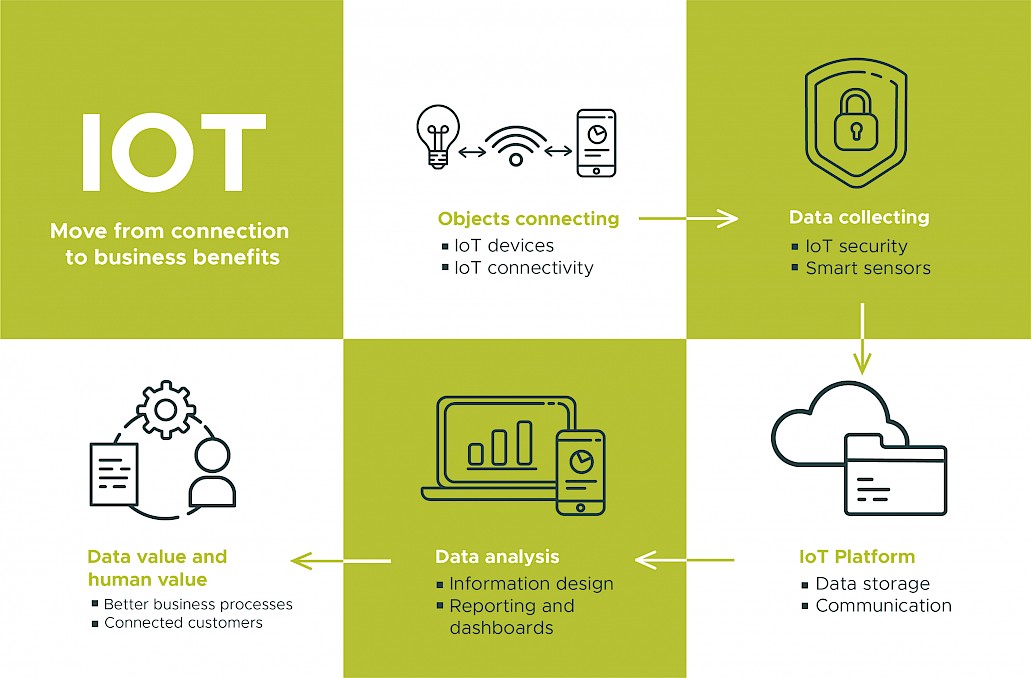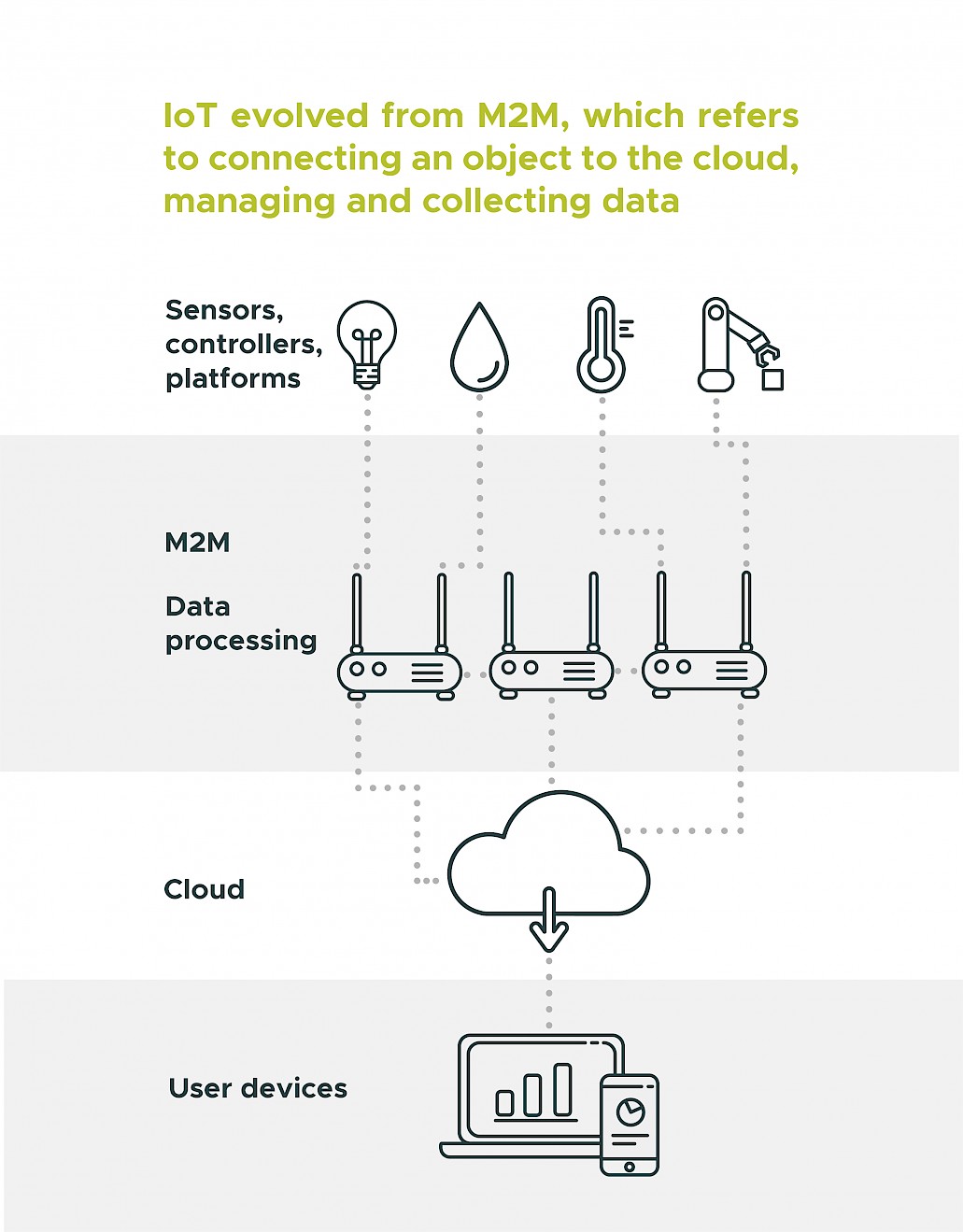The Internet of Things
Wouldn't it be great to have a hot espresso waiting for you at home and be able to make it simply through an application while you are en route? Wouldn't you like to control all applications in your home remotely? Or then again perhaps you can have remote access to information about your house conditions like room temperature and humidity, electric utilizations or devices safety? This is only a hint of something larger - IoT is empowering things around you to send data over the internet, that can improve our quality of life, make it easier, better, environmental friendly and save our time & money.
The ‘Internet of Things’ phrase is actually being shown everywhere: there is a focus on IoT, smart devices and their impact on every aspect of people's lives. But what is the Internet of Things? What do people say about it? Is it just a hype or actually our future? And is it seriously so important?
So, what is the meaning of IoT?
According to the Oxford Dictionary, IoT is “the interconnection via the Internet of computing devices embedded in everyday objects, enabling them to send and receive data”. The University of Cambridge provides a similar definition: “objects with computing devices in them that are able to connect to each other and exchange data using the internet”.
IoT surrounds us and it goes far beyond simple Facebook posting or internet surfing. IoT is about connecting things (objects, machines, etc) to the internet in order to transmit data, enable them to talk to each other, so they can be remotely monitored and controlled. IoT makes opportunities resulting in efficiency enhancements, financial benefits, and decreased human efforts. It’s a world where things are becoming active participants in smart processes. IoT won't work without Artificial Intelligence (AI), that deals with simulations of smart behaviors - it works on the data using techniques such as ML (machine learning) to take actions that improve or optimize processes, predict the mistakes and errors. IoT is all about smart sensors, while AI is all about system behavior.
How IoT works
Internet of Things simply enables objects around us to query and update their status on the internet. It is a huge network of connected smart devices and people, which share the most valuable data. IoT devices exchange information by connecting to the IoT gateway where data is sent to the cloud. Business processes can also adjust their behavior in response to constant setting refreshes. What’s more, the information picked up by smart objects enables one to make smarter decisions, save time and resources.

IoT impacts human life and provides high-value thanks to connectivity and data analyzing.
Businesses can take advantage of IoT - if you can implement that many smart devices in your house, imagine the possibilities for your business. Make sure that your company derives the greatest value from IoT, including productivity improvement, alerting of a potential risk and suggestions for commuters.
IoT evolution
The idea of connected devices has been around since the 1970s, but the man who first mentioned the internet of things was Kevin Ashton, co-founder of the Auto-ID Center at MIT, in 1999 during the presentation he made to Procter & Gamble. IoT has evolved from the convergence of wireless technologies, microelectromechanical systems (MEMS), microservices, and the internet. The convergence helped to permit unstructured machine-produced information to be analyzed for insights that will drive enhancements. The Internet of Things is basically an arrangement of machines or items outfitted with information gathering innovations so those devices can speak with each other. The machine-to-machine (M2M) information that is generated is observed as an approach to determine the wellbeing conditions. M2M typically relies on communication provided via wired networks, and it’s a simple device-to-device communication becoming a tangible solution that connects businesses to their connected machines.
IoT is also a natural extension of supervisory control and data acquisition (SCADA), the application program for collecting data in real-time from many locations to control the conditions. SCADA systems incorporate hardware and software parts. Hardware accumulates and feeds information into a PC that has SCADA software introduced, where it is then prepared and presented when the time is right. It additionally records and logs all occasions into a document stored on a hard disk. SCADA applications also warn when conditions become perilous by sounding alerts.
How it works - four main components of the IoT system

According to Forbes “the combined markets of the Internet of Things (IoT) will grow to about $520B in 2021, more than double the $235B spent in 2017. [...] System integration, data center and analytics, network, consumer devices, connectors, and legacy embedded systems are the six core technology and solution areas of the IoT market.”
Examples of IoT
Examples on the Internet of Things can include security frameworks, vehicles, home appliances and many many more - organizations can use IoT applications to mechanize security assignments to performing genuine world A/B testing.
There are various true uses of the web of things, extending from consumer IoT and enterprise IoT to assembling and IIoT (industrial IoT). IoT applications range various verticals, including aviation, energy and automotive. In the purchaser fragment, for instance, smart homes with brilliant indoor regulators, smart machines and associated warming, lighting and electronic gadgets can be controlled remotely through PCs and smartphones. For the customer, it's all tied in with time-saving, finding a greater approach to live and to work, making things simpler. One of the best smart home systems is Google Assistant, which can speak to apps like Spotify. If you tell Google Assistant “I don’t like this song”, it will skip to the next one.
Wearable gadgets with sensors can gather all the information, sending messages to different technologies about the customers with the point of making their lives simpler. Wearable gadgets are additionally utilized for the wellbeing - for instance, improving people on call's reaction times during emergencies by giving essential signs and alarms. The smart motorcycle helmet is operated by voice acknowledgment software, offering up a whole load of features that the rider would miss out on otherwise. This includes everything from a heads-up display to GPS tracking and even a rear-view camera.
Now imagine that you can enjoy your journey with no worries about the baggage loss. Traveling with Versa - smart luggage tracker that you place inside your bag - help you avoid unpleasant situations, because you know where your baggage is.
https://grinn-global.com/portfolio/versa/
Smart metering
Smart buildings can reduce energy consumption and other utility costs using a smart network of sensors. The advanced smart metering solutions for process automation enable real-time monitoring, data analysis, and comparison. It is easy and convenient with remote problem resolution. The systems consist of software and sensors that monitor parameters such as energy, water, gas, heat, and temperature. Data from IoT devices is sent to the app and presented in a user-friendly format. Scalability, constant access to data and quick billing help reduce media consumption and increase savings. Rhino can help you reduce energy consumption and deliver savings while ensuring safety. That system is simple to use and can be rolled out as needed, to measure one single point or a complex range of parameters.
IoT in healthcare
In medicine, IoT offers numerous advantages, including the capacity to monitor patients for example. Hospitals and other medical clinics use IoT frameworks in order to administrate the stock, but most of all to improve patient care, ensure high-quality care and save lives. A Continuous Glucose Monitor is a device that helps diabetics to continuously monitor their blood glucose level, providing glucose readings on your smartphone and notifies you about dangerous low or high glucose level. Now imagine that there is a solution not only for the patient but also for medical clinics, healthcare centers and hospitals that have to prevent infectious disease transmission. A device that improves patient care, ensures high-quality healthcare and save lives: touch-free hand sanitizer Sani nudge.
https://grinn-global.com/portfolio/saninudge/
Smart city
IoT sensors such as smart lights or smart meters in cities, for example, can help reduce traffic. Smart controllers with communication gateway allow remote management of solar lights also. DOLL (Danish Outdoor Lighting Lab) is Europe's biggest test field and innovation center inside smart lighting. It showcases smart city arrangements across IoT communications frameworks, environmental monitoring, mobility, parking, waste management and substantially more.
IoT in agriculture
The most recent radar innovation for agro-business, using great IoT solutions for better stock control and more advantageous farms. IoT-based frameworks can help monitor temperature, lighting, humidity, using sensors. IoT is additionally instrumental in computerizing water system frameworks. For example GreenIQ is a product that uses smart agriculture sensors, and it allows you to manage your irrigation and lighting systems remotely.
IoT in agriculture as a Silo spider solution means using an adaptable device for better stock control and healthier farms. How does it work? It is mounted on top of agricultural silos, measures levels of feed in the silos and helps farmers and suppliers better monitor feed levels and maintain orders as required.
https://grinn-global.com/portfolio/silospider/
IoT security and protection issues
The internet of things associates billions of gadgets to the internet and includes the utilization of billions of information focuses, all of which should be verified. Because of its extended assault surface, IoT security and IoT protection are now referred to as real concerns. “In all but the most restrictive environments, you’re going to have IoT devices in your midst,” says Jason Taule, VP of standards & CISO at security standards and assurance company HITRUST. "The question then isn’t if, but how you are going to allow such devices to connect to and interact with your networks, systems, and data”. IoT security can be accomplished with a coordinated arrangement that conveys visibility, division, and insurance all through the whole system infrastructure.
What's next to come?
IoT is turning into an increasingly developing point of discussion both in the working environment and outside of it. It's an idea that not just can affect how we live, but also how we work. The new principle for what's to come will be: whatever can be connected, will be connected. But why in the world would you need such a large number of connected things conversing with one another? There are numerous models for what this may resemble or what the potential worth may be.
There are approximately 12 billion gadgets that can at present associate with the internet, and scientists estimate that by 2020 there will be multiple times more associated things than individuals. As indicated by Gartner, purchaser applications will drive the number of associated things, while enterprise will represent the vast majority of the income. IoT appropriation is developing, with assembling and utilities evaluated to have the biggest introduced base of Things by 2020.
What are the top 10 emerging trends and technologies that will drive the Internet of Things over the next five years? The Gartner expert Nick Jones jumps into a wide cluster of IoT concerns, including on-chip identity, security, and AI ethical IoT; novel wireless systems; infonomics; IoT administration models; and edge and fog structures. We'll also distinguish a few advanced technologies which are significant but more niche or over-hyped and take a long time and a lot of effort to reach their maximum potential.
Sources:
https://www.lexico.com/en/definition/internet_of_things
https://dictionary.cambridge.org/pl/dictionary/english/internet-of-things
https://business.albertslund.dk/projects/danish-outdoor-lighting-lab/
https://www.networkworld.com/article/3404198/7-things-you-can-do-to-enhance-iot-security.html
